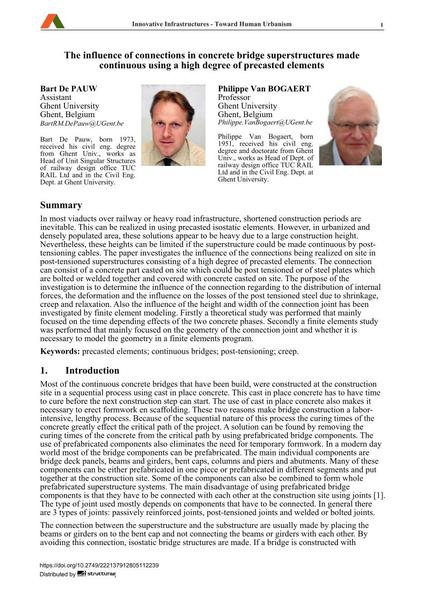The influence of connections in concrete bridge superstructures made continuous using a high degree of precasted elements

|
|
|||||||||||
Détails bibliographiques
| Auteur(s): |
Bart De Pauw
Philippe Van Bogaert |
||||
|---|---|---|---|---|---|
| Médium: | papier de conférence | ||||
| Langue(s): | anglais | ||||
| Conférence: | 18th IABSE Congress: Innovative Infrastructures – Towards Human Urbanism, Seoul, Korea, 19-21 September 2012 | ||||
| Publié dans: | IABSE Congress Seoul 2012 | ||||
|
|||||
| Page(s): | 1611-1618 | ||||
| Nombre total de pages (du PDF): | 8 | ||||
| DOI: | 10.2749/222137912805112239 | ||||
| Abstrait: |
In most viaducts over railway or heavy road infrastructure, shortened construction periods are inevitable. This can be realized in using precasted isostatic elements. However, in urbanized and densely populated area, these solutions appear to be heavy due to a large construction height. Nevertheless, these heights can be limited if the superstructure could be made continuous by post- tensioning cables. The paper investigates the influence of the connections being realized on site in post-tensioned superstructures consisting of a high degree of precasted elements. The connection can consist of a concrete part casted on site which could be post tensioned or of steel plates which are bolted or welded together and covered with concrete casted on site. The purpose of the investigation is to determine the influence of the connection regarding to the distribution of internal forces, the deformation and the influence on the losses of the post tensioned steel due to shrinkage, creep and relaxation. Also the influence of the height and width of the connection joint has been investigated by finite element modeling. Firstly a theoretical study was performed that mainly focused on the time depending effects of the two concrete phases. Secondly a finite elements study was performed that mainly focused on the geometry of the connection joint and whether it is necessary to model the geometry in a finite elements program. |
||||
